Nutrition in Plants for Class 7
Introduction to Nutrition in Plants
Every living thing needs food to provide energy to operate, grow, and reproduce. Plant nutrition is the study of the chemical elements & compounds necessary for plant growth, plant metabolism, and their external supply. While animals need other organisms for food, the majority of plants can construct food out of sunlight, water, and carbon dioxide. This is called photosynthesis. On the other hand, some plants are not able to produce their own food & therefore use other sources for food. These plants also use heterotrophic nutrition.
Types of Nutrition in Plants
There are two types of plant nutrition:
-
Autotrophic Nutrition – Plants make their own food from sunlight, water, & carbon dioxide.
-
Heterotrophic Nutrition – Certain plants rely on external organisms or outside sources for nutrients.
Autotrophic Nutrition in Plants
What is Autotrophic Nutrition?
Plants prepare their food themselves from inorganic substances such as water and carbon dioxide in the presence of sunlight & come under the category of autotrophic nutrition. Autotrophs are the ones that use this mode of nutrition.
How Do Autotrophs Prepare Their Food?
The green pigment called Chlorophyll that is present in the leaves traps the solar energy used by the autotrophs. This energy is used in the process of photosynthesis, where water & carbon dioxide are converted into glucose (food). During this process, oxygen is released as a necessary byproduct that aids in the sustainance of life on Earth.
Photosynthesis – The Process of Food Preparation in Plants
What is Photosynthesis?
Photosynthesis is the biochemical reaction used by Autotrophs (green plants) for synthesizing their food in the presence of sunlight, carbon dioxide, and water. Photosynthesis Comes from Greek Words:
-
Photo = Light
-
Synthesis = To make
So, photosynthesis means “make food with light.”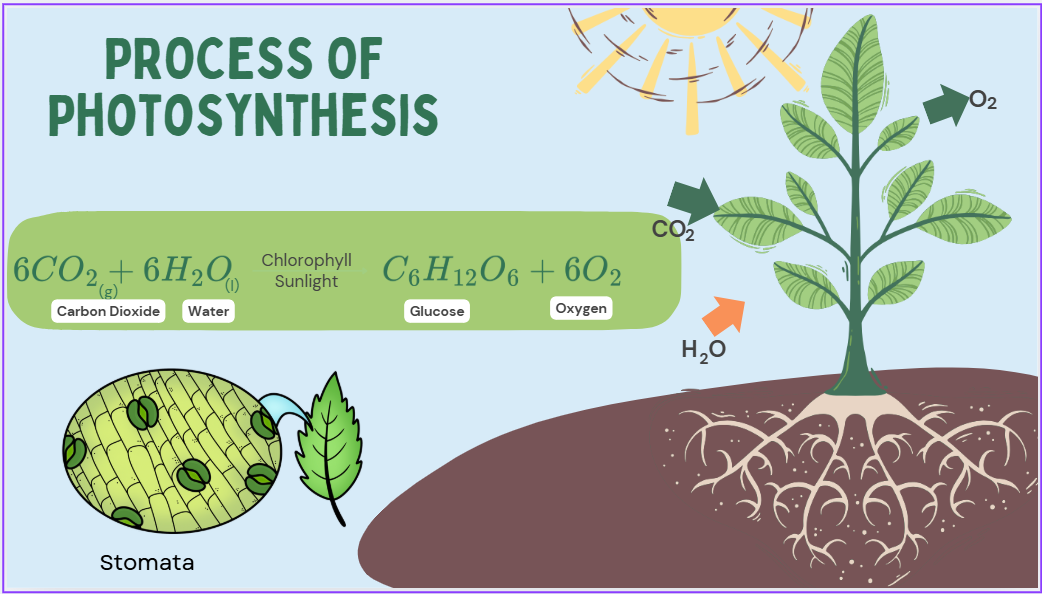
Where Does Photosynthesis Occur?
Sunlight reacts with chloroplasts inside the cells of the leaf and is trapped in a green pigment called chlorophyll, & this process is also known as photosynthesis.
Raw Materials for Photosynthesis
-
Sunlight – Provides energy for the process.
-
Water (H₂O) – Absorbed by roots from the soil.
-
Carbon dioxide (CO₂) is absorbed from the air through tiny openings called Stomata.
-
Chlorophyll – The green pigment that traps sunlight.
Conditions Essential for Photosynthesis
Certain conditions must exist for photosynthesis to occur. In such conditions, plants can effectively convert light energy to chemical energy & prepare their food. The four necessary conditions for photosynthesis are:
1. Presence of Chlorophyll
Chlorophyll is the green pigment found in chloroplasts, the specific organelles of plant cells. Its key function is harvesting sunlight, which drives photosynthesis. Plants are incapable of capturing light & performing photosynthesis in the absence of chlorophyll.
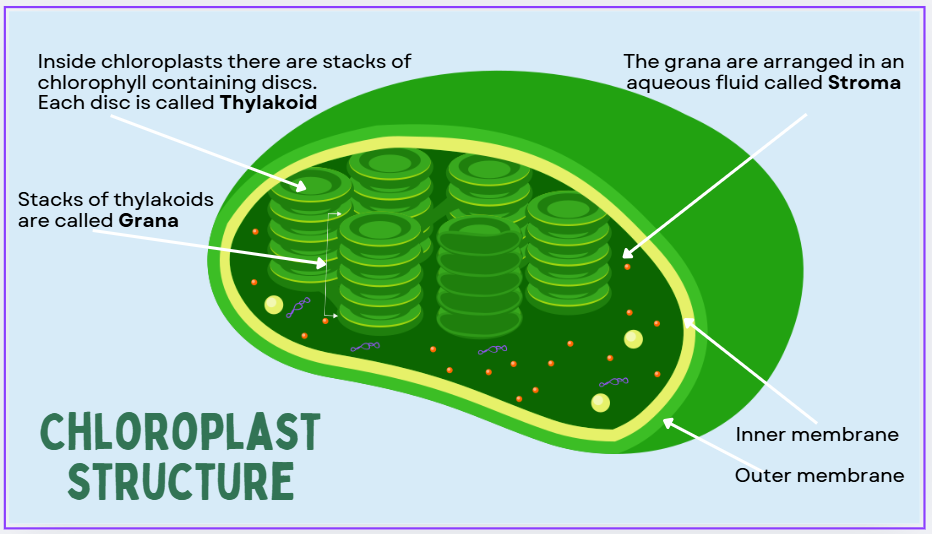
Example:
- Green leaves do photosynthesis as the leaves contain chlorophyll.
- Some examples of these kinds of plants are Cuscuta (Dodder plant), which are chlorophyll-less plants, therefore unable to photosynthesize, and thus needing other plants to provide food for them.
2. Presence of Light
The amount of sugar is dependent on sunlight as it is the main energy source for photosynthesis. Chlorophyll absorbs light energy & uses it to split water molecules into hydrogen and oxygen. This energy is then harnessed to take carbon dioxide from the atmosphere and convert it into glucose (food).
3. Availability of Carbon Dioxide (CO₂)
Photosynthesis uses carbon dioxide as a raw material. Plants take in CO₂ from the air through small pores called stomata, which are mostly located on the bottoms of leaves. And stomata (the plural of stoma) open to allow CO₂ from the atmosphere into the leaves for food production.
4. Availability of Water (H₂O)
Photosynthesis requires another raw material: water. The roots take up & transport it to the leaves through the xylem. In photosynthesis, water molecules, split into hydrogen and oxygen, aid in the creation of glucose.
When plants lack water, they wilt, and they also have a reduced rate of photosynthesis.
Heterotrophic Nutrition in Plants
What is Heterotrophic Nutrition?
Unlike Autotrophs, some plants cannot prepare their food. These plants rely on other organisms or external sources for nutrition, following heterotrophic nutrition. Such plants are called Heterotrophs.
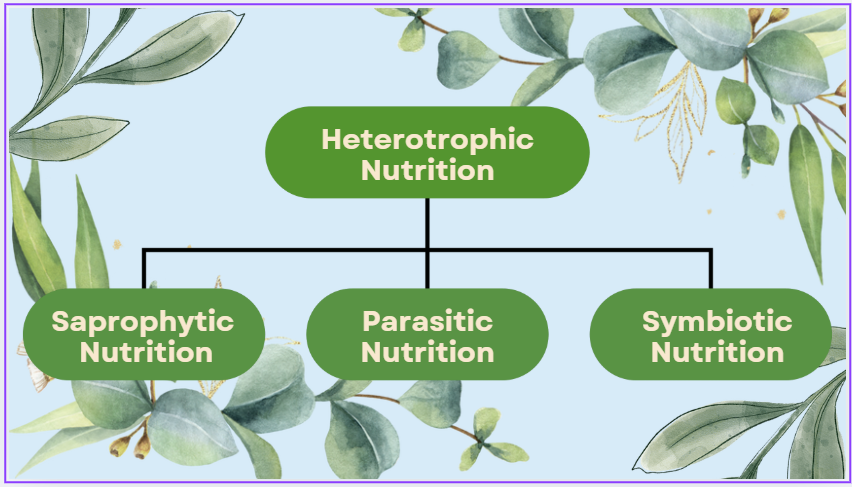
Types of Heterotrophic Nutrition
Heterotrophic plants are classified into the following types:
Saprophytic Nutrition
Definition
Plants that feed on dead & decaying organic matter follow saprophytic nutrition. These plants are called Saprotrophs. They release digestive enzymes to break down complex organic substances into simpler compounds, which they then absorb.
Examples of Saprophytic Plants
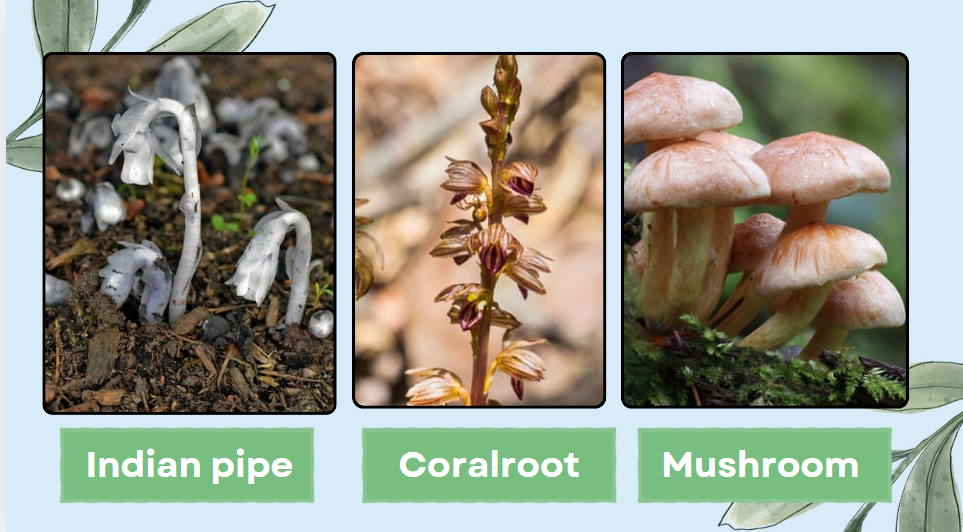
Parasitic Nutrition
Definition
Some plants depend on other living plants for food. These plants follow parasitic nutrition, deriving nutrients from the host plant while harming it. Such plants are called Parasitic Plants. In this kind of nutrition, one organism derives its nourishment from another organism (host). Such organisms that derive nutrition from other organisms are termed as parasites.
There are two types of parasites:
Exoparasite: Parasite that lives outside the body of other organisms. Examples: lice on the scalp of humans, leeches, bed bugs, etc.
Endoparasite: Parasite that lives inside the body of other organisms. Example: Tapeworm in the alimentary canal of humans.
Now, let us explore the two types of parasitic plants.
1. Total parasite: A total parasite is completely dependent on the host for its nourishment. Cuscuta (Dodder or Amarbel) is an example of a total parasite. It can be seen in the form of yellow tubular structures twining around the stems and branches of the plant. It lacks chlorophyll & hence cannot prepare its own food. It is totally dependent on the host on which it grows for nourishment. As it weakens the growth of its host plant, agriculturists consider Cuscuta as a ‘destructive weed’.
2. Partial parasite: A partial parasite is partially dependent on the host for its nourishment. Mistletoe (Viscum) is an example of a partial parasite. It has chlorophyll & hence can prepare its own food. It is dependent on the host (for example, the Western Australian Christmas tree) for getting water and minerals. Viscum is attached to the roots of host plants with the help of haustoria (root-like structure) to get water & minerals.
Examples of Parasitic Plants:
-
Cuscuta (Dodder plant) – A total parasite that lacks Chlorophyll and depends entirely on the host.
-
Mistletoe – A partial parasite that absorbs water & minerals but can produce its own food.
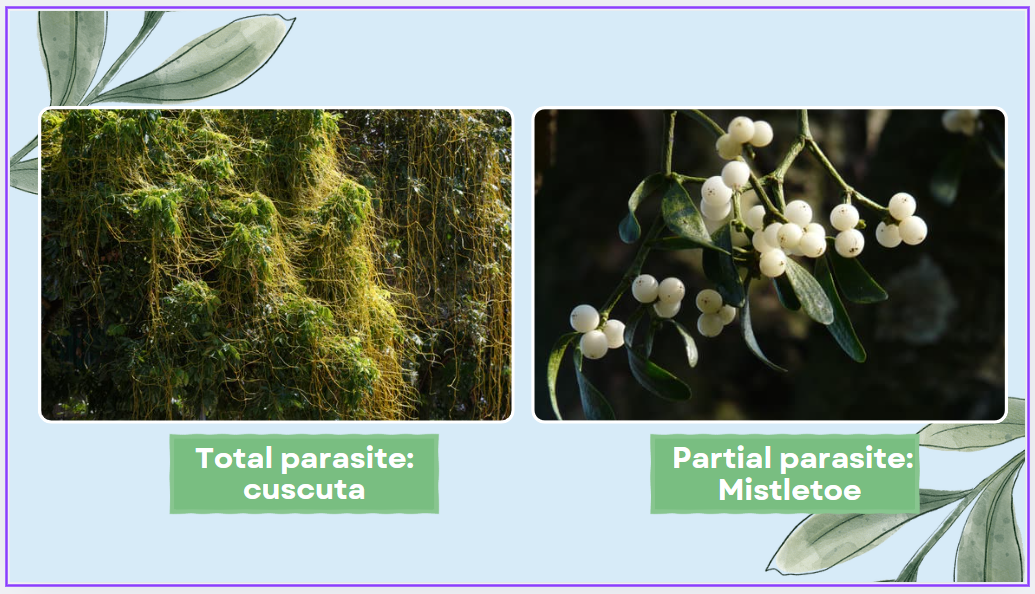
Symbiotic Nutrition
Definition
In symbiotic nutrition, two organisms live together in a mutually beneficial relationship (Sym = together & bios = life). In a symbiotic relationship, two organisms live together & are beneficial to each other.
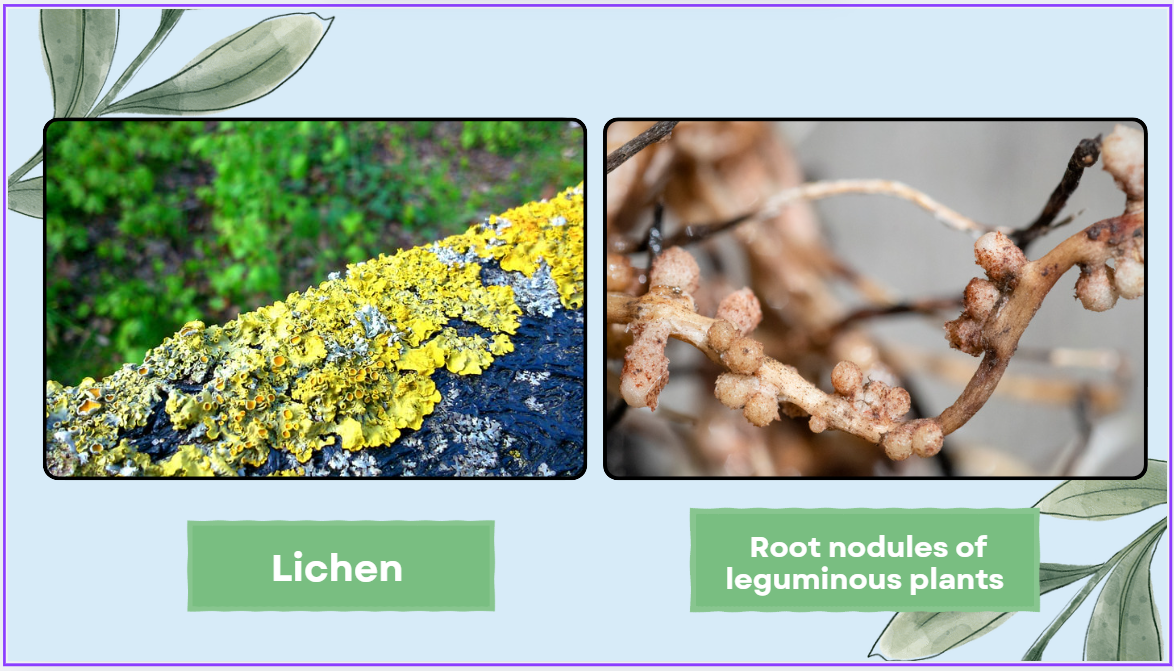
Example: Lichen
Lichen is an example of symbiotic association between algae (phycobiont) and fungi (Mycobiont). Algae is green in colour & synthesises its own food by the process of photosynthesis. It provides food to the fungi, and in return, fungi provide shelter, water, and minerals to the algae. This association helps both of them to live in adverse conditions. Some fungi live in the roots of trees. Fungi increase the surface area for absorption of water and minerals & in return, get food from the tree.
Leguminous plants
One more example of symbiotic nutrition is the root nodules of leguminous plants (peas, beans, etc.) and rhizobia bacteria. Nitrogen is required for the synthesis of proteins. The plant cannot absorb the nitrogen directly. The rhizobia bacteria convert nitrogen into nitrates or ammonia (usable soluble form). The roots absorb these nitrogenous compounds to fulfil the plant’s nitrogen requirement. In return, bacteria get nutrition and shelter from the plant. You must have observed farmers using manure & fertilizer.
Insectivorous Plants
Definition
Some plants grow in nutrient-poor soils and trap insects to fulfill their nitrogen needs. These are called insectivorous plants. The plants that grow in nitrogen-deficient soil eat & digest insects to fulfill their nitrogen requirement. These plants are green & can prepare their own food. These plants are also termed ‘carnivorous plants. ’ These plants attract insects with the help of their attractive color, odour, and nectar and lure them into traps.
Let us see some examples of insectivorous plants:
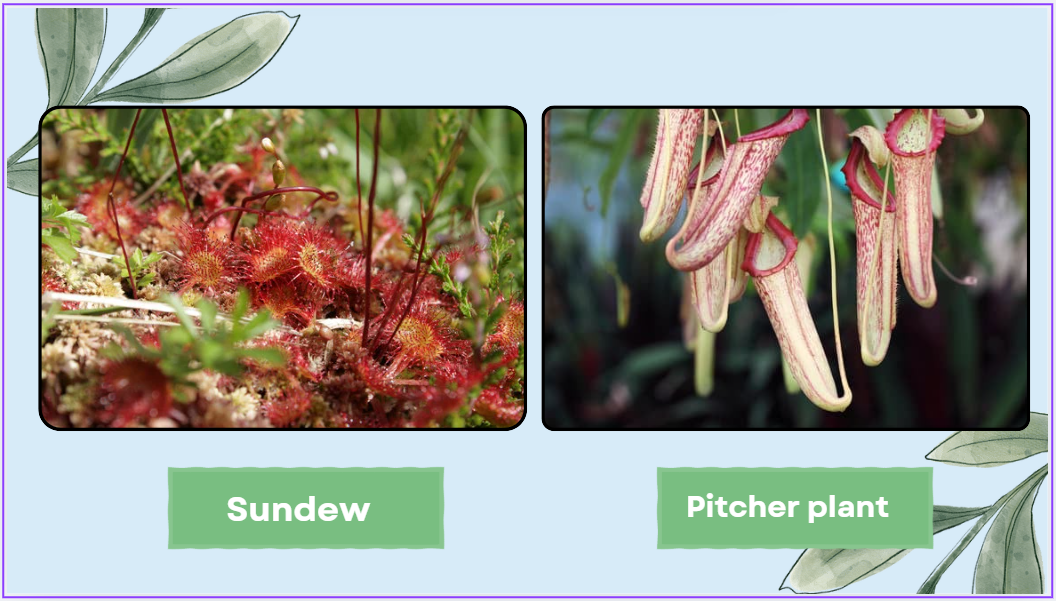
Drosera (Sundew): It has long, thin structures called tentacles. These tentacles have mucilaginous glands that help attract insects. Once an insect sits on it, it gets caught in the mucus, and the tentacles fold inward, trapping the insect.
Nepenthes (Pitcher plant): The leaves are modified in the shape of a pitcher. The leaf apex is modified in the form of a lid that can be opened or closed. The walls of the pitcher secrete nectar that attracts insects. The edge of the pitcher's opening is slippery. The insect sits on it and slips into the pitcher & the plant traps the insect by closing the lid. The digestive juices secreted within the leaf help in the digestion of the insect. In this way, the plant fulfills its nutritional requirement for nitrogen.
Soil and Nutrients
Why Do Plants Need Soil Nutrients?
Plants require essential minerals like nitrogen, phosphorus, and potassium for growth. Over time, these nutrients get depleted.
How Are Nutrients Replenished in Soil?
-
Decomposers (like bacteria & fungi) break down organic matter.
-
Nitrogen Fixation by Rhizobium bacteria in leguminous plants.
-
Crop Rotation prevents the depletion of specific nutrients.
-
Fertilizers and Manure enrich the soil.
Nutrition in Plants is a fundamental process for their growth & survival. While Autotrophs prepare their food via photosynthesis, Heterotrophs rely on other sources. Various specialized Heterotrophic nutrition types, such as Saprophytic, Parasitic, Symbiotic, and Insectivorous nutrition, highlight the diversity of plant adaptation. Soil nutrients are replenished through natural cycles & agricultural practices, ensuring a healthy ecosystem.
Things You Have Learned!
- Understand how plants make their own food through photosynthesis using sunlight, water, carbon dioxide, and chlorophyll.
- Identify the difference between autotrophic and heterotrophic nutrition in plants.
- Explore the types of heterotrophic nutrition – saprophytic, parasitic, symbiotic, and insectivorous.
- Recognize the role of soil nutrients like nitrogen, phosphorus, and potassium in plant growth.
- Learn how soil nutrients are replenished through decomposers, nitrogen fixation, crop rotation, and fertilizers.

